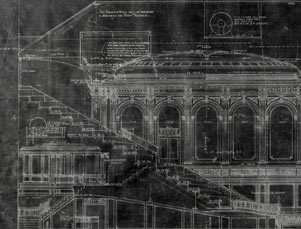








HISTORY
The Majestic Theatre was originally built in 1927 by real-estate magnates, the Chanin Brothers, as part of a three-theatre complex that also included the Royale (a mid-sized house) and the Theatre Masque, now the John Golden (a small house). The Majestic, a large musical house, complemented the other two venues, enabling producers to move shows based on their ticket sales to the most appropriately-sized venue. In 1930, the Chanins transferred ownership of all three houses to the Shuberts.
ARCHITECTURE
The Chanins commissioned Herbert Krapp to design the theatre complex in what he called a “modern Spanish” style, complete with terra-cotta base and Spanish brick-wall ornamentation, and arched windows. The Majestic's exterior also includes a stylized Palladian motif above the entrance. The interior features the Adam-style detailing common in many Shubert houses. Decades before the current vogue for stadium seating in movie theaters, Krapp had conceived of a similar concept for the theatre's orchestra. With its steep rake, it offers ideal sight lines for audience members. Another forward-thinking aspect of the design was the creation of a single large balcony rather than two smaller ones—today’s producers are hesitant to book two-balcony houses because second-balcony seating is less desirable to modern audiences.
Spotlight on Broadway: Majestic Theatre from Spotlight on Broadway on Vimeo.
Access Information
Theatre is not completely wheelchair accessible.
There are no steps into the theatre from the sidewalk. Please be advised that where there are steps either into or within the theatre, we are unable to provide assistance.
Shubert Audience Services
The Majestic Theatre provides accommodations for patrons who are blind, deaf, partially sighted, and/or have hearing loss. The theatre provides infrared assistive listening devices for every performance at the theatre. In addition, beginning four weeks after a show’s official opening night performance, hand-held audio description devices and hand-held captioning devices are available, and there is unlimited access to downloadable audio description and/or captioning for personal mobile devices free of charge. (Hand-held devices are limited, although additional devices can be obtained with at least twenty-four hours’ notice.) If you have questions, contact Shubert Audience Services at 212-944-3700 or audienceservices@shubertorg.com. There is also a representative at the Shubert Audience Services kiosk at every performance to assist any patron with any of our devices, software, or technology.
Accessibility by Seating Section
Orchestra Location: There are steps to the Orchestra beginning with row I. There are no steps to the designated wheelchair seating location. No steps to rows AA - H.
Mezzanine Location: Located on 2nd level, up 3 flights (51 steps). Please Note: On the Mezzanine level, there are approximately 2 steps up/down per row. Entrance to Mezzanine is behind row G of the front Mezzanine.
Handrails: Available at every stepped-row,except in the Mezzanine and Rear Orchestra, where handrails are only available on the far side aisles.
Wheelchair | Companion Seat Locations:
Orchestra: D18 | D12-16; C17 | D13-17; C18 | C12-16; C19 | B13-17
Aisle Seat with Folding Armrest | Companion Locations:
Orchestra: G2 | G4; F19 | F17; H1 | H3; W114 | W113; T1 | T3; V2 | V4
Elevator/Escalator
None available.
Payphone
Located in the lobby. Accessible at 54".
Restroom
There is a wheelchair accessible restroom.
Theatre Policies
The use of cameras, recording devices, cell phones, beepers, and other electronic devices during the performance is prohibited. Everyone attending a performance must have a ticket. Latecomers will be seated at the discretion of management. Wheelchair and mobility-impaired seating is intended for patrons with mobility disabilities. Children under the age of four years will not be admitted. No outside food or beverage permitted, unless medically necessary. No weapons permitted on the premises.
THEATRE SPECS
Majestic Theatre
245 West 45 Street
Between Broadway and 8th Avenue
New York NY 10036
| Year Built | 1927 | |
| Seating Capacity | ||
| Orchestra | 885 | |
| Front Mezzanine | 292 | |
| Rear Mezzanine | 436 | |
| Boxes | 32 | |
| Standing | 36 | |
| Total | 1681 | |
| Included in Numbers Above: | ||
| Wheelchair | 4 | |
| Aisle Transfer Arms | 17 | |
| Theatre Dimensions | |
| Proscenium Opening: | 40' 10" |
| Height of Proscenium: | 30' 10" |
| Depth to proscenium: | 37' 10" |
| Depth to front of stage: | 47' 10" |
| Stage Type: | Proscenium |


















